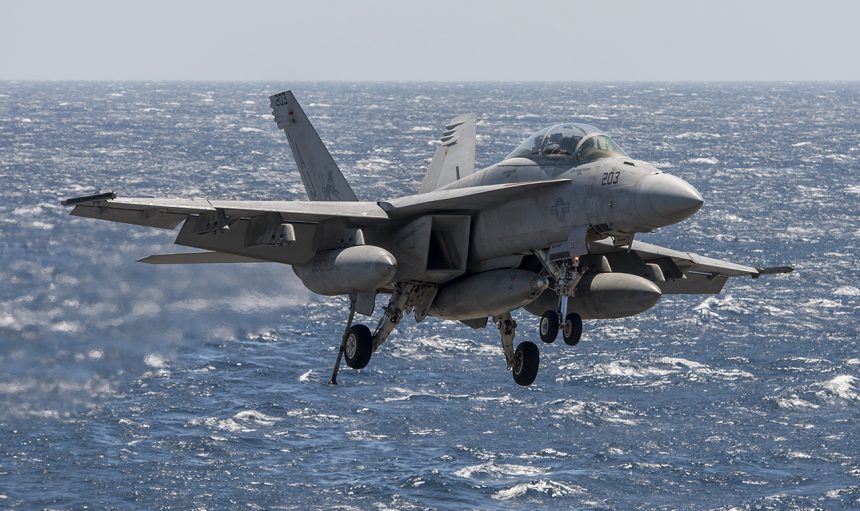Aircraft Was from Strike Fighter Attack Squadron (VFA) 213 On Routine Training Sortie. It’s the 14th major incident involving a Hornet of any variant since May 2016.
A U.S. Navy Boeing F/A-18F Super Hornet two-seat combat aircraft crashed at approximately 4:30 PM EDT, Wednesday, March 14, 2018 near Key West, Fla. Both crew members are being reported as dead after being transported to Lower Keys Medical Center in Florida. Reports indicate the crew did eject from the aircraft prior to the crash. The aircraft was from Strike Fighter Attack Squadron (VFA) 213 “Black Lions” based at Naval Air Station Oceana, Virginia. The aircraft went down one mile east of the runway on landing approach to Boca Chica Field, Naval Air Station Key West when the accident occurred.
Photos from the crash location show the aircraft with gear and hook down, upside down on the surface of water; other amateur shots show an SH-60 Seahawk helicopter hovering over the same area after the F/A-18F appears to have submerged.
Just received a new pic from the F/A-18 crash site off Key West. Unbelievable, glad the aircrew made it out. pic.twitter.com/Mur0vUPE7B
— Hope Hodge Seck (@HopeSeck) March 15, 2018
According to an official statement released by the commander, Naval Air Forces Atlantic, “Search and rescue crews were notified shortly after the crash where they recovered both the pilot and weapons systems officer from the water approximately one mile east of the runway. Both were taken by ambulance to Lower Keys Medical Center,” A later announcement read, “Both aviators have been declared deceased. Per Department of Defense policy, the names of the aviators are being withheld until 24 hours after next-of-kin notification.”
The Boeing F/A-18F Super Hornet is a twin-engine, two-place multi-role combat aircraft widely used by the U.S. Navy primarily in the ground attack role. The aircraft is also being operated by the Royal Australian Air Force. It is a more advanced version of the original F/A-18 Hornet multi-role aircraft introduced by McDonnell Douglas.
Here’s what The Aviationist’s David Cenciotti wrote last summer when reporting about an F/A-18E of Strike Fighter Squadron (VFA) 146 assigned to the USS Nimitz (CVN 68) that departed the runway during an emergency landing at Bahrain International Airport on Aug. 12, 2017 (the pilot successfully ejected):
Dealing with the F/A-18E/F Super Hornet fleet, four aircraft were lost (fortunately resulting in 0 fatalities) including the one lost last week: two VFA-211 F/A-18F jets from NAS Oceana collided and crashed 25 miles E of the Oregon Inlet, Nags Head, NC on May 26, 2016; earlier this year, on Apr. 21, 2017, a VFA-137 F/A-18E crashed during a landing attempt on USS Carl Vinson (CVN 70) in the Celebes sea, between Indonesia and the Philippines.
Legacy Hornets are crashing at an even more alarming rate: two U.S. Marine Corps F-18 Hornets from MCAS Miramar crashed on Nov. 9, 2016 near San Diego. Another F/A-18C crashed near USMC Air Ground Combat Cente, Twentynine Palms, on Oct. 25, 2016. A U.S. Navy F/A-18C belonging to the Strike Fighter Wing Pacific, Detachment Fallon, crashed on Aug. 2, 2016, 10NM to the south of NAS Fallon. On Jul. 27, 2016 a USMC F/A-18 belonging to the 3rd Marine Aircraft Wing crashed during a night strafing run on a weapons range near Twentynine Palms (killing the pilot). On Jun. 2 a Blue Angels Hornet crashed after taking off from Smyrna/Rutherford County Airport (KMQY), Smyrna, Tennessee: the only pilot on board was killed in the incident.
Aircraft may crash for a variety of reasons, not always technical ones. Still, the rate of Hornet crashes in the last years seems to be unusual and, as such, concerning.
According to a report published in September 2016 by Stars and Stripes, since 2012, the number of major Navy and Marine Hornet and Super Hornet accidents have increased by 44 percent as a consequence of sequestration and subsequent cuts in flight hours for training at home.
Moreover, F/A-18 Hornets of all variants have shown a steady yearly increases of what the Navy calls “physiological episodes” due to oxygen deprivation and cabin decompression since May 1, 2010, and the U.S. Navy has linked the deaths of four Hornet pilots that occurred over a span of 10 years to “physiological episodes” (PE). Such deadly incidents are not all the direct result an oxygen system failure but are linked by the fact that pilots experienced various symptoms that fall within the scope of a PE: dizziness, vertigo, oxygen shortage, blackouts, etc.
The Super Hornet incident in Bahrain was the second involving a Super Hornet in 2017, the fourth one since May 2016. But it was not the last one. In October 2017, a Spanish EF-18 Hornet, belonging to the Ala 12, crashed during take off from its homebase at Torrejon Air Base, near Madrid, killing the pilot. Then, in January this year, a Royal Australian Air Force EA-18G Growler, the electronic warfare variant of the Super Hornet, caught fire during take-off at Nellis AFB, Nevada while participating in the Red Flag 18-1 combat training exercise. Both crew members were uninjured in the incident.









